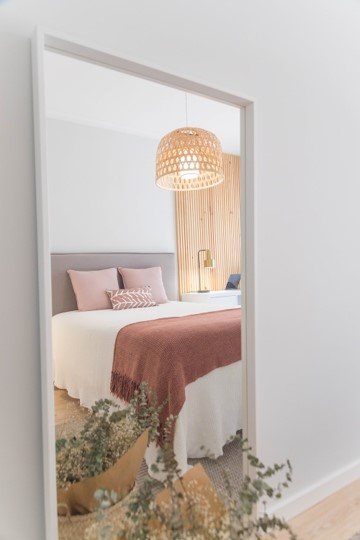Guest Blog By ScandiShop
Use a color scheme
A color scheme should be chosen that is relaxing, to create visual flow and complement the decor. It’s also important to embrace minimalism, letting art breathe and not overcrowding an area with too many pieces.
Unsplash
1.Pick a relaxing color palette
When it comes to choosing a color scheme for your home, you want to create an environment that is peaceful and serene.
While there are many ways of achieving this ambiance, one way is by using color palettes. Color palettes can be used in decorating your home or even just paint colors for walls.
Spacejoy
There are different types of color schemes based on the type of mood or atmosphere you are trying to achieve. For example, if you want a calming effect on your space then try using soft pastel tones like pink and blue which tend to have soothing effects on people’s emotions.
Spacejoy
On the other hand, if you have kids who play sports often then maybe having bright bold colors will help them focus more easily as opposed to dull shades such as grey or brown which tend not only look boring but also make it hard for people like artists who need brightness around them when painting their masterpieces!
2.Create visual flow
Creating a visual flow is about creating harmony between the colors in your home, and it's an easy way to make rooms look bigger.
SANDRA REI
Let's say you have a small bedroom with white walls, but you want it to feel spacious. The easiest way to do this is by choosing a color scheme that flows from room to room, so the room doesn't feel like it ends abruptly when you enter it from its adjoining space.
The same goes for larger spaces: if you want one large space to seem more cohesive and connected, choose colors that complement each other as they move throughout your home (think of how blue and green work together.)
Color can also be used as a powerful mood-setter.
Jason Wang
In this case color helps draw attention towards or away from certain things in any given space—like art or furniture pieces—so they become focal points instead of just sitting there looking bland all on their own!
3.Choose decor that complements
• Choose furniture that complements your color scheme.
• Use artwork that complements the scheme.
• Choose accessories and accents that complement the scheme.
• Use a rug, curtains or upholstery fabric that complements the scheme.
• Choose furniture that works with your chosen colors and feel of each room to create a cohesive look throughout your home!
4.Embrace minimalism
Unsplash
Now that you have your color scheme in place, it’s time to start implementing minimalism. Minimalism is about removing excess so that you can focus on what matters most in life. It’s also about embracing simplicity and letting go of things that don’t add value to your everyday life. The benefits of minimalism are many:
• When there are fewer things to look at, you save time and energy by not having to figure out what to wear or clean the house every day (or maybe even every week).
• You get more done because less stuff means less clutter causing distraction as you work on other things.
5.Let art breathe
Kam Idris
Art is one of the most powerful ways to add color and personality to your home.
No matter what type of art you choose—a painting, a sculpture, or even a framed photo—you can use it to create contrast in your space. If it looks good and suits the room's purpose (don't put a large canvas on top of an antique cabinet if you want something that blends), any piece will do.
And don't think you're limited to just one piece!
Josh Hemsley
Adding multiple pieces of similar style can also help break up the monotony in any given room. For example, if all your furniture is white but there are too many different colors going on throughout each item, try grouping together pieces with similar shades rather than attempting to match them up with each other individually; this will give your space more cohesion while still allowing for some variation within each item's overall aesthetic.
You can follow these tips to calm your space down
Christopher Jolly
• Choose a color scheme based on calming colors, like beige, white and blue. These tones are known for their relaxing properties, so they work well as an overall palette for a room or house. If you want to go even further with it, make sure your furniture's finish is matte (not shiny) and cool (not warm). This will help keep everything looking relaxed instead of busy or overwhelming your senses.
Victoria Akvarel
• Create visual flow in your home by using color accents throughout all rooms instead of just having one big pop color like reds or yellows everywhere in every piece of furniture or accessory; this makes it easier on the eyes while still being fun! You can also use plants or flowers around windowsills where light comes through; they're great because they add some green into any room without much effort required at all!
Max Vakhtbovych
• Choose decor items that complement rather than clash with each other: For example if there's wallpaper behind one chair but not another then consider using different fabrics instead (like cotton versus silk), since those two materials aren't usually found together often enough elsewhere within an interior design context anyway - unless you're into mixing them up yourself through DIY projects such as quilting sessions where both fabrics come together often enough; but again this may not always be possible depending upon what type/style works best within each space itself."
You can make your home more peaceful by using color schemes and decor that will help you relax. The key is to create a soothing space that helps you feel calm and at ease so that you can enjoy life with less stress. The first step to this might be purchasing new furniture.
Read Next
Does the process of picking a paint color for your walls make you want to run and hide? Do you feel like there’s just too many choices and too many mistakes to be made? Let me show you my top 4 favorite – fool proof- ways to pick paint colors for any room in your home. It’s way easier than you think!
Join the Fun!
If you enjoyed this post and you want to keep seeing my weekly blog, the best way to do that is to subscribe.
You can subscribe by downloading my 11 Secrets Only Designers Know to Make Your Space Rock. If you’re curious about how decorators and designers make a home look magazine ready, you’ll love taking a gander at these 11 secrets. You’ll learn how to style your room from the floor up and it will work for ANY space you have.
I write about small space design and decorating, sustainable furniture options, positive self care and a variety of do-it-yourself home décor.
I’d love to connect with you!
“Michael Helwig was top-notch, very professional and responsive to my needs. He allowed me time to explore ideas and try out a variety of combinations until we found the perfect fit. Michael provided detailed information and offered beautiful ideas to make my dream living room become a reality. The furniture he sourced has totally transformed my living room space. Everyone that has seen my new living room has one word, WOW! A special thank you to Michael for a wonderful experience.”
“Michael was very knowledgeable and guided us, with great patience and good humor, through the process of designing our dining room and helping us find the perfect sleeper sofa. He offered really helpful advice when we asked questions - which was often - but at no time did we ever feel pushed. He helped me when I felt like I couldn’t make one more decision. When my new furniture finally arrived I realized everything down to the pillows was perfect. I couldn’t be happier!”
Mikhail Nilov
SkandiShop is a Nordic design furniture store that enables anyone to make their home a little bit more beautiful.
The opinions and views expressed in any guest blog post do not necessarily reflect those of Michael Helwig Interiors or its Principal, Michael Helwig. Michael Helwig Interiors, and Michael Helwig, do not have any affiliations with any products or services mentioned in the article or linked to therein. Guest Authors may have affiliations to products mentioned or linked to in their author bios.



















